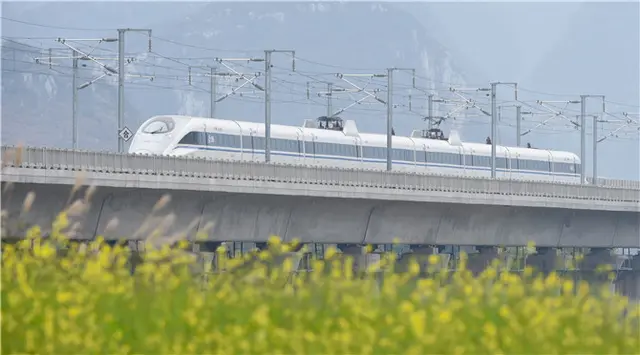China on Wednesday put one of the world's longest high-speed railways into operation, linking the country's prosperous eastern coast with the less-developed southwest.
The Shanghai-Kunming line -- 2,252 km in length -- traverses five provinces, Zhejiang, Jiangxi, Hunan, Guizhou and Yunnan, and cuts the travel time from Shanghai to Kunming, capital of Yunnan Province, from 34 to 11 hours, according to China Railway Corporation.
The maximum speed is 330 km per hour, said Wang Jingda, a train driver.
The line is also the longest east to west high-speed railway in China. The north to south 2,298-km Beijing-Guangzhou line is even longer and started in 2012.
China has built more than 20,000 km of high-speed rail lines. The mileage will increase to 45,000 km by 2030. The launch of the Shanghai-Kunming line means the country's high-speed rail grid has taken shape, connecting almost all provincial-level regions on the Chinese mainland.
Attendants are seen at the Kunmingnan Railway Station in Kunming, capital of southwest China's Yunnan Province, Dec. 28, 2016.Photo: Xinhua
On Wednesday another high-speed rail line, linking Kunming and Nanning, capital of southwest China's Guangxi Zhuang Autonomous Region, was launched.
Yunnan is home to 25 indigenous ethnic minorities. Attendants on the Shanghai-Kunming line are trained to be multilingual. One of the attendants Yang Yanzhu, for example, speaks eight local languages.
The Shanghai-Kunming line has been touted by some as the most beautiful high-speed railway route in China as many of the train stops are tourist sites. Yunnan, itself, is a big draw for Chinese tourists as the region boasts snow-capped mountains, canyons, tropical forests, and ethnic villages.
The annual growth of the city's tourist arrivals will double after the operation of the high-speed train line, Kunming Municipal Tourism Development Commission said.
"Yunnan tourism will get a boost. People can reach their destinations faster and spend more time relaxing," said Ming Qingzhong with Yunnan University of Finance and Economics.
Passengers of ethnic minority sit on a bullet train on the Shanghai-Kunming high-speed railway at the Kunmingnan Railway Station in Kunming, capital of southwest China's Yunnan Province, Dec. 28, 2016. Photo: Xinhua
But it is not all about scenery. The rail line connects Yunnan with one of the country's most vibrant economic powerhouses -- the Shanghai-centered Yangtze River Delta economic zone.
The size of the Yunnan economy was about half that of Shanghai in 2015. Local governments and business people expect the connection may help the land-locked provinces of Yunnan and Guizhou to develop.
With the high-speed train, travel time between the two provincial capitals is reduced from seven hours to only two.
Yunnan's border trade with Thailand, Myanmar and Vietnam is also expected to get a lift.
"It will be faster for us to travel on high-speed trains," said Chandara, a Laotian businessman. "I am so excited."
(APD)
 简体中文
简体中文



